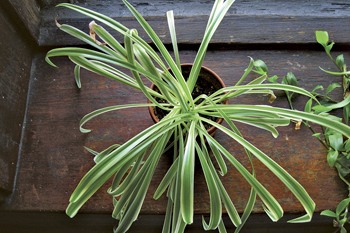
Dear EarthTalk: Do houseplants really improve indoor air quality? Which ones are the most effective as such? ~ Kay Hamm, Los Angeles, CA
In recent years, more and more people have developed an interest in keeping houseplants. There are many potential reasons why there has been such a resurgence in indoor gardening. Many people took up tending to houseplants during the pandemic as a quarantine hobby. As the years have progressed, people’s interest in keeping houseplants has continued to thrive and it’s easy to understand why. They liven up any living space, and provide people with something to care for—both which provide many mental health benefits. However, there has been speculation as to whether or not keeping houseplants provides environmental and health benefits through purifying the air in our homes.

The short answer is that houseplants do have the potential to purify the air in our homes. When plants perform photosynthesis, they take carbon dioxide out of the air and emit oxygen as a byproduct. Since plants output oxygen into the surroundings, by scientific definition they have the potential to increase the oxygen concentration in your living space. However, the degree to which they can detoxify the air and measurably make a difference to the air quality in a person’s living space is another matter.
“There is currently no evidence…that a reasonable number of houseplants remove significant quantities of pollutants in homes and offices,” reports the U.S. Environmental Protection Agency. Indeed, in order to make a considerable difference in the air quality of your home, you’d have to keep a large number of houseplants under specific climatic conditions, requiring a large amount of effort, time and money that isn’t realistic for most of us. Having houseplants can even worsen indoor air quality if you are overwatering them, as overly damp soil may promote the growth of microorganisms which can affect allergic individuals.
However, if you are interested in keeping houseplants that have the potential to clean the air in your home, there are a variety to choose from. There are two major air pollutants found in homes: particulates—dust, mold, etc.—and volatile organic compounds (VOC)—gases that are released from materials such as fabric, paint and cleaning products. Spider plants, philodendrons, ZZ plants, dumb canes, pygmy date palms and ivies are among the plants suited to indoor living that are especially good at filtering out particulates. Other plants especially good at removing volatile organic compounds (VOCs) out of your indoor air include pathos, bamboo, Areca palms, rubber plants and peace lilies. You can usually find a wide assortment of indoor plants — and get more advice — at a local nursery or garden center.
Of course, there are also many other ways to improve the air quality of your home. Keeping a clean home reduces the amount of particulate matter in the air. Investing in air purifiers and home air filters can help reduce both the concentration of VOCs and particulate matter that could be impairing your indoor air quality. Simple tasks like opening your windows and airing out your home in the warmer months increases air circulation and benefits your home’s indoor environment.
Dear EarthTalk: Why are coyote sightings so much more common in urban areas these days? Should I be worried about kids and pets outside? Is this a bad sign for the environment at large and is there a humane way to deter these carnivores from residential areas? ~ Max B., Norwalk, CT
Coyotes, known as the Song Dogs of North America, are the sole canid predator endemic to North America. They can be found as far north as Canada and Alaska, and as far south as Central America, but are most prevalent in the Great Plains, where they began their outward migration 100 years ago. Since the 1950s, they’ve managed to expand their territory by 40 percent, and can now be found anywhere from remote plains to bustling urban parks.

As many experts agree, the coyote is an incredibly adaptive animal. This evolutionary advantage has kept the species not only surviving, but thriving in response to human expansion. This is one of the reasons the coyote has prevailed where other species have faltered, and why their sightings have only increased along with urbanization. Coyotes are flexible creatures on many counts: their time of activity, their preferred habitat, even their diet. When they aren’t eating rabbits or small rodents, coyotes can be seen eating small fruits like berries and apples, and even vegetables like carrots to maintain their daily caloric needs.
Coyotes also have flexible temperaments. They are aggressive enough to hunt small prey, but skittish enough to avoid deadly human contact. Indeed, coyotes are relatively harmless to humans (but they will definitely eat a small pet!). A 2021 study from Madison, Wisconsin discovered that most human-coyote interactions were benign, lacking any aggression by the coyotes whatsoever. When participants in the study were asked to pick a number from zero (calm) to five (aggressive), 90 percent chose zero.
That being said, they are not completely harmless to humans and should always be approached with caution. Last year, four people were injured by a coyote in San Francisco, including a four-year-old.
Counterintuitively, of all the factors influencing coyote population increases, one of the greatest may be population control. According to multiple studies conducted since the 1970s, the indiscriminate killing of coyotes, which has occurred for decades across all of North America, causes what is known as pack disruption, whereby normally “sterile” females become sexually active in a pack when an alpha male or female is killed. This phenomenon inevitably led to a positive feedback loop, where the encouragement of hunting reduced coyote population levels in the short-term, but increased them in the long-term.
Coyotes are considered a keystone species, meaning their presence or absence significantly influences an ecosystem. This also means their overabundance can lead to ecosystem disruption.
If you’re looking to humanely deal with a coyote, hazing—waving your arms and yelling—is often considered the best method of deterrence. Keeping pets inside and livestock penned securely is also encouraged, as is the removal of any garbage or pet food that you may have outside.
EarthTalk® is produced by Roddy Scheer & Doug Moss for the 501(c)3 nonprofit EarthTalk.
See more at https://emagazine.com. To donate, visit https//earthtalk.org.
Send questions to: question@earthtalk.org.

